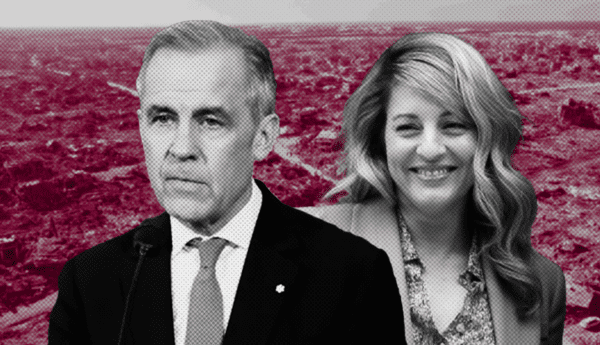4. 1. 2025
From Trade War to Class War
John Clarke
As the threat of a trade war between the US and Canada emerged, Todd Gordon, writing in Midnight Sun, set out the need for a response based on working-class solidarity. At the same time, he rejected an approach based on national unity and argued that “nationalism is a political dead end for the left in Canada, no less today than in previous periods when it ensnared progressives.”
I share the view that an independent working-class strategy is needed and that any patriotic alliance with our class enemies would be disastrous. Donald Trump isn’t known for restrained conduct and his pursuit of global trade wars has been true to form. Severe measures have been accompanied by threats, bluster, and changes of direction. Nonetheless, his protectionist approach is escalating, as we can see from the Financial Post’s concise tariff tracker. On March 4, after delays and failed negotiations, a general tariff of 25% was imposed on many Canadian goods, with a 10% tariff on energy products and critical minerals. Retaliatory measures impacting billions of dollars in US imports followed rapidly. The American tariffs on Canadian products were then adjusted on March 6 to exclude goods covered by the Canada-United States-Mexico Agreement (CUSMA). On March 12, a further 25% tariff was levied on Canadian steel and aluminum exports and more countermeasures were adopted. Ontario also briefly increased the price of the electricity it sends to several US states, though this move was suspended.
This isn’t a complete picture, but it certainly indicates the severity of what is unfolding. And it’s clearer than ever that what we need today is working-class resistance, not cross-class nationalism.
America First
Trump’s protectionist measures against Canada are part of a global strategy that reflects a decisive shift in how the US behaves on the world stage. This has come to be described as the “America First” approach. The hegemonic power of the US is in decline as it deals with regional and global rivals, most notably China. This greatly changed reality has been asserting itself for some time, but it has built to the point where the ruling establishment of the US is now driven to redefine the role it plays in the world. Trump’s Secretary of State, Marco Rubio, captured this thinking in an interview with Fox News, where he suggested that at an earlier time, “We were the only power in the world, and so we assumed this responsibility of sort of becoming the global government in many cases, trying to solve every problem… [But] it’s not normal for the world to simply have a unipolar power… So now more than ever we need to remember that foreign policy should always be about furthering the national interest of the United States.”
To Trump and those around him, representing the most reactionary and reckless elements within the ruling establishment, the solution to this relative decline of US power is to withdraw from the role of “trying to solve every problem” and to use the still-considerable military and economic strength of the US to force better terms from friend and foe alike. In 2017, scholar Robert Sagan, in a brief for the Brookings Institution, bemoaned the danger that “the liberal world order established in the aftermath of World War II may be coming to an end, challenged by forces both without and within.” This was referring to a global system in which systems of trade, finance, and international relations were conducted under US supervision. The transactional Donald Trump has no patience for such multilateralism and the polite fictions of the “rules-based” order. To him, the way forward is to ditch the expenses and responsibilities of world leadership and run a global extortion racket. The tariff is one of his main weapons in this regard, used to contain rivals, force concessions from allies, and impose US dictates on lesser powers.
This is not to advance a moral comparison in which a relatively benign form of US imperialism has given way to something more rapacious. US hegemony has always taken the form of a global system of violence and exploitation, and Trump hasn’t changed that. But under the impact of greatly altered global circumstances, the US executive branch is jettisoning concerns for international stability and order in favour of the pragmatic pursuit of immediate benefits. The Biden presidency, by comparison, had been supposed to restore US global stewardship. In 2020, the New Yorker expressed the hope that Biden could “reeëstablish the moral leadership of the West” and return to “a values-based foreign policy.” He would begin this work by “being the un-Trump.” Yet the Biden restoration proved to be a debacle. As the BBC bitingly concluded, “His current place in history is as the Democratic interregnum between the two Trump presidential terms. A blip, rather than a pivot.” Trump has returned to power strengthened by this failed attempt to preserve an alternative to the course he sets.
Class war
The developing trade war between the US and Canada is not a short-term policy adjustment or traceable only to Trump’s personal whims. Major historical developments have driven the turn to US protectionism. We are dealing with a transformed global hegemon.
It must be said that Canada is both a G7 power and a global exploiter in its own right, as Todd Gordon argues in his Midnight Sun article mentioned above. Gordon is absolutely right to challenge nationalistic notions of Canada as something akin to a beleaguered US colony. As he points out, “While US entities constitute half of all foreign owners of Canadian business assets, foreign ownership in general accounts for less than 15% of all business assets in Canada, a figure that has been declining for decades in many sectors and in the aggregate.”
Nevertheless, the developing trade war has enormously serious implications for the Canadian state. A fact sheet issued by Scotiabank shows that trade with the US “accounted for 77% of total Canadian goods exports and 63% of Canadian goods imports, but only 18% of total US goods exports and 14% of US goods imports.” Moreover, “Exports to the US were responsible for roughly 19% of Canadian GDP in 2023.” These figures clearly demonstrate that the US turn to protectionism is generating a major crisis for Canadian capitalism that poses a threat to working-class people and raises vital questions regarding the struggles we must take up.
The strategies pursued by Canada’s capitalist class in the period ahead will focus on the preservation of profits, and this will mean intensified exploitation of workers. Debates are underway in high places about whether compromises with Trump should be sought or the emphasis placed on retaliatory measures. There’s also a great deal of talk about diversifying trade and seeking out new export markets. In any of these approaches, trade war will intensify class war. If Canadian governments comply with Trump’s demands and accept harsher trading terms, assuming such compromises are possible, this will cut into profits, but the same is true of a protracted escalation of tariffs and countermeasures. In either case, we may expect extensive layoffs and workplace closures, along with demands for concessions from workers. Defending the so-called national interest will require increased “competitiveness”: attacks on workers, along with cuts to social programs.
The notion of a united patriotic effort that is waged in everyone’s best interest is a lie or distortion when advanced by the ruling class, but politicians and the media are pushing it with great enthusiasm. Mark Carney, an experienced agent of capitalist interests and now Canada’s prime minister, has assumed a leading role in this effort. In his victory speech after winning the Liberal leadership, he set aside any pretence at subtlety and told the crowd: “Americans should make no mistake. In trade, as in hockey, Canada will win.”
Left nationalism and its alternatives
As this patriotic fervour is whipped up, Canadian nationalism – including left nationalism – becomes a serious problem, because it ties the working-class movement to an agenda that is inherently under the control of the ruling class. While working-class interests may be acknowledged and demands around workers’ rights and social provision put forward, nationalist perspectives suggest there’s a unified “national interest” that must be protected in the face of US encroachment. This stance can only impede the development of the independent working-class perspective that is so urgently required.
The working class has to operate in a context that is dominated by its class enemies. We didn’t generate the rivalries among them or draw the borders between states, but we have to advance our interests under the conditions imposed upon us. Our class has nothing to gain from the trade war and no responsibility to find solutions for Canadian capitalism. Our viewpoint should be shaped by hostility to “our” capitalists and robust solidarity with workers in the US and Mexico.
Sadly, but not surprisingly, the notion of a united Team Canada has resonated significantly as the trade war has developed. In part, this is due to an upsurge of patriotic feeling that we may expect to weaken as price-gouging capitalists and ruthless employers demonstrate that we are most definitely not all in this together. At the same time, some trade union leaders have adopted a measure of the collaborationist logic that comes with the concept of a national class alliance. On March 14, for example, the union Unifor issued a statement headed “Unifor calls for Prime Minister Carney to unite team Canada.” While it called for workers and communities to be protected in this period of crisis, the statement is defined by the notion of common purpose with the class Carney represents. Very unfortunately, it included no mention of solidarity with working-class struggles against Trump that are taken up south of the border.
The writing is already on the wall when it comes to ruling-class efforts to make working-class people carry the burden of the trade war. Since the threat of tariffs emerged, corporate lobbyists have taken up a campaign to eliminate “interprovincial trade barriers.” What they are actually proposing is that the limited measures that have been taken at the provincial level to protect workers, communities, consumers, and the environment should be reduced to the lowest common denominator. In February, as he addressed a business audience, Bank of Canada governor Tiff Macklem ominously echoed this call.
In the face of such attacks, there can be no level of cooperation with “our” capitalists and their political agents. We will need to advance clear demands, but they can’t be put forward in a spirit of mild admonition, as if we might try to remind Bay Street titans and cabinet ministers that working-class people are part of the “team” as well. We are going to need fighting demands that are linked to uncompromising mass struggles. Workers’ rights must be defended, workplace closures challenged, and demands for workers’ concessions resisted with powerful strikes. Staring down a massive assault on working-class living standards, we will have to take to the streets to demand income support measures that protect people from job losses and the impacts of inflation. Far from accepting more austerity, we must push for our badly weakened social infrastructure to be improved dramatically. That means restoring healthcare systems and dealing with Canada’s housing crisis.
The trade war with the US will become an intensified class war against the Canadian working class. Rather than sit around the table with our enemies pursuing a mythical “national interest,” we need to make sure this period of crisis is one in which working-class resistance is taken to entirely new levels. The upsurge of cross-class nationalism that is being whipped up at the moment will doubtless continue and even intensify during the first weeks of the crisis, and those who seek to advance distinct working-class interests will have to swim against the stream initially, as the flag-waving mood predominates. However, it will not be lost on workers and hard-pressed communities that the capitalist wing of this patriotic alliance and their political representatives have their own hostile agenda. Class realities will assert themselves and the possibilities for working-class resistance will increase.
The forms that the struggle will take can’t be predicted with any certainty, of course. Which groups of workers will give a lead in fighting employer demands for concessions, or what austerity measures will ignite resistance, have yet to be determined. It is even possible that forms of working-class resistance in the US or Mexico might provide the examples that inspire and mobilize fightbacks in Canada. The best we can do at present is develop demands and campaigns that are centred on the working-class needs that arise under conditions of escalating trade war. The “workers-first agenda” advanced by Justice for Workers is a compelling example and an important lead.
Nationalistic illusions notwithstanding, the ruling establishment in Canada won’t be able to conceal its class agenda, and the prospect of major struggles will be created. In this context, the vital task will be to advance in every way possible an independent, militant, and internationalist working-class perspective that can unleash powerful strikes and community-based forms of mass action.
John Clarke is a former organizer with the Ontario Coalition Against Poverty (OCAP) and currently a member of 230 Fightback, an organization that is fighting for social housing in Toronto’s Downtown East. He facilitates a course for union and community activists on “Fighting to Win.”
Related:
- Moments of Vast Possibility Solidarity Winnipeg’s Jesslyn Best and Leslie Ep discuss utopias, popular uprisings, gender and sexual freedom, communist politics, and speculative fiction with M.E. O’Brien and Eman Abdelhadi, the authors of the new book Everything For Everyone: An Oral History of the New York Commune, 2052-2072.
- What We Mean by Community is Our Yearning for Communism M.E. O’Brien on family abolition and the communizing of care as political horizons worth fighting for. A conversation with Midnight Sun editor David Camfield.
- Protest & Pleasure: A Revolution Led by Sex Workers A conversation with Monica Forrester, Toni-Michelle Williams, and Chanelle Gallant about why trans women of colour sex workers are the leaders we need, lighting the way to revolutionary horizons.
- Festivals of the Possible Megan Kinch on the Occupy movement, which erupted 10 years ago: its particular blend of spontaneity, organization, and technology; the forms it took in Toronto and elsewhere in Canada; and its mixed legacies. A personal and political reflection.






